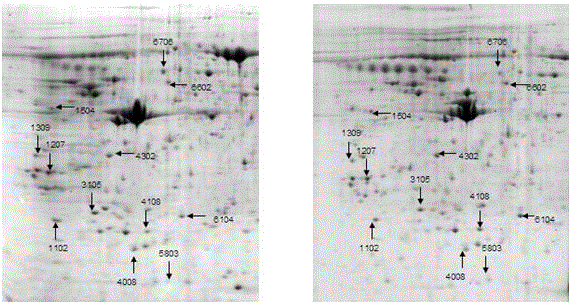Kidney yin deficiency syndrome animal model biomarker screening and determining method
A technology of biomarkers and animal models, which is applied in the field of screening and determination of biomarkers of animal models of kidney yin deficiency, can solve the problem of affecting the selection of prescriptions and medications for treatment and the evaluation of clinical efficacy, difficult to objectify and quantify, and evaluation indicators Lack of specificity, objectivity and other issues, to achieve the effect of promoting scientific evaluation and easy carrier
- Summary
- Abstract
- Description
- Claims
- Application Information
AI Technical Summary
Problems solved by technology
Method used
Image
Examples
Embodiment 1
[0037] Establishment and identification of model rats with kidney yin deficiency:
[0038] 1 Experimental consumables
[0039] 1.1 Experimental animals
[0040] A total of 60 male 3-month-old healthy SPF grade WISTAR rats, weighing 200-240 g, were purchased by the Experimental Animal Center of Fujian University of Traditional Chinese Medicine from Shanghai Slack Experimental Animal Co., Ltd., experimental animal license number: SCXK (Shanghai) 2012 -0002, laboratory animal quality certificate number: 2007000583560. Experimental animal use license number of the Experimental Animal Center of Fujian University of Traditional Chinese Medicine: SYXK (Fujian) 2014-0001.
[0041] 1.2 Main reagents and drugs
[0042] Table 1 Main reagents and drugs
[0043]
[0044] 1.3 Main Instruments
[0045] Table 2 Main Instruments
[0046]
[0047] 2 Experimental methods
[0048] 2.1 Preparation of Thyroid Tablet Suspension
Embodiment 2
[0062] Screening of differential proteins, which includes the following steps:
[0063] 1. Extraction of total cortical bone protein ① Cut the frozen fresh femur stem with bone scissors, rinse the bone marrow with ultrapure water, and gently scrape off the cancellous bone of the femoral stem with a curette, then put it into a mortar (in advance liquid nitrogen precooling), cut into 1 mm with bone scissors 3 Add liquid nitrogen to the mortar and grind it quickly, repeat the grinding 3 to 5 times, take the powder and weigh it, and then add protein sample lysate according to the ratio of 1 g bone tissue to 1.5 mL lysate, Place in 4°C refrigerator to lyse and extract protein for 4 hours (mix well once every 1 hour); ② Place the EP tube containing the bone tissue suspension in a low-temperature high-speed centrifuge, centrifuge at 14,000rpm at 4°C for 1 hour, and absorb the supernatant ③ Add nuclease: add 2 ul DNase and 2 ul RNase to each 1 ml lysate, and place on ice for 15 minut...
Embodiment 3
[0088] Western Blot and RT-PCR technology double verification from protein and gene level, it includes the following steps:
[0089] 1 Western Blot detection of bone-related protein in femoral shaft cortex of rats in each group
[0090] 1.1 Extraction of total cortical bone protein. Randomly extract 8 rat femur dry cortical bones from each group in the -80°C freezer, place them on ice, quickly cut the bone tissue into pieces with a rongeur, and put them into a pre-cooled grinder Grind quickly to a powder form, add liquid nitrogen to cool at the right time during the grinding process, then transfer to an Eppendorf tube, weigh; add 1 ml of lysate to 1 g of bone tissue according to the proportion, oscillate with a micro-vortex for 5 s, and then place In the refrigerator at 4 °C, vortex shake once every 30 min, take it out after 4 h; transfer to a low-temperature high-speed centrifuge, set the program at 4 °C, 14000 rpm, centrifuge for 20 min, and absorb the supernatant.
[0091]...
PUM
 Login to View More
Login to View More Abstract
Description
Claims
Application Information
 Login to View More
Login to View More - R&D
- Intellectual Property
- Life Sciences
- Materials
- Tech Scout
- Unparalleled Data Quality
- Higher Quality Content
- 60% Fewer Hallucinations
Browse by: Latest US Patents, China's latest patents, Technical Efficacy Thesaurus, Application Domain, Technology Topic, Popular Technical Reports.
© 2025 PatSnap. All rights reserved.Legal|Privacy policy|Modern Slavery Act Transparency Statement|Sitemap|About US| Contact US: help@patsnap.com



